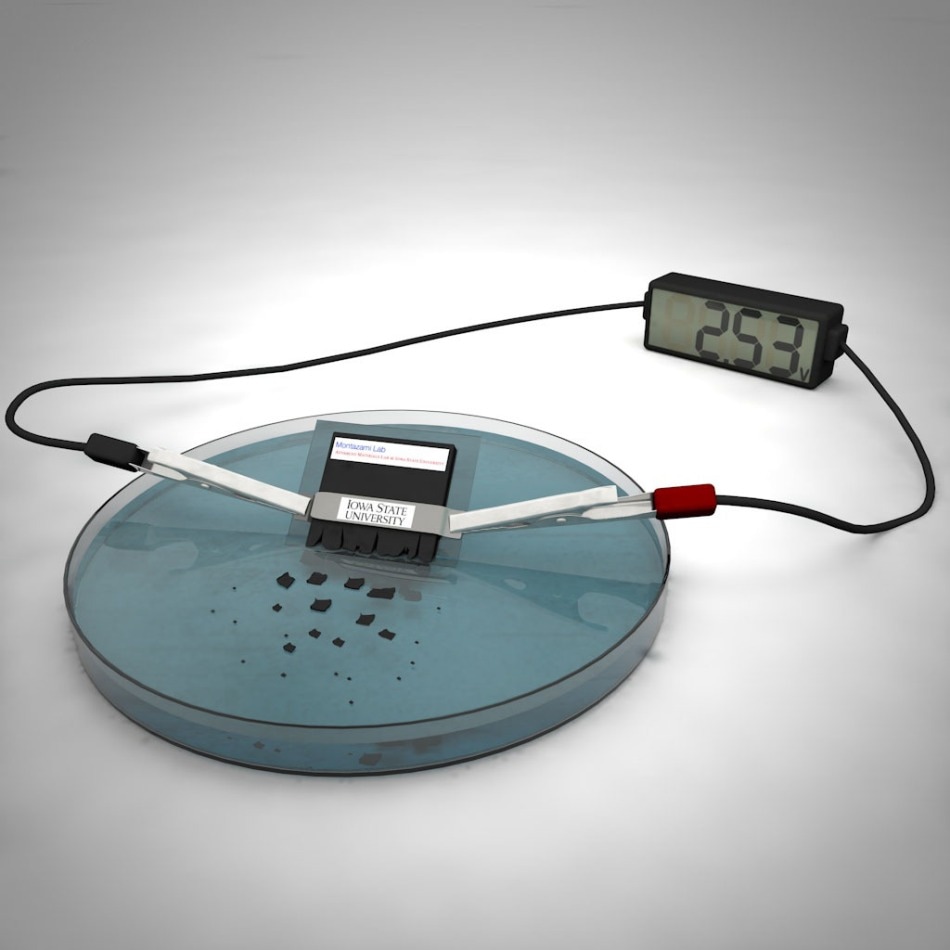Aug 8 2016
 Iowa State scientists have developed a working battery that dissolves and disperses in water. (Scientific illustration by Ashley Christopherson.)
Iowa State scientists have developed a working battery that dissolves and disperses in water. (Scientific illustration by Ashley Christopherson.)
Electronic devices that self-destruct when required could keep military secrets from the enemy or they could keep patients away from the pain of removing a medical device. They could even enable environmental sensors to sweep away in the rain.
Developing this type of device is the aim of a new research called “transient electronics.” These types of transient devices could carry out a wide range of functions until they are exposed to light, heat or liquid that cause their destruction.
Reza Montazami, an assistant professor of mechanical engineering at Iowa State University and an associate of the U.S. Department of Energy’s Ames Laboratory, has been exploring transient technology for many years.
A self-destructing, lithium-ion battery that can deliver 2.5 V and disperse or dissolve in 30 minutes after being dropped in water is the recent development from his laboratory. This battery has the capacity to power a desktop calculator for nearly 15 minutes.
Montazami stated that this is the first transient battery that demonstrates stability, service life and power for practical use.
Montazami and his colleagues recently published their research finding in the Journal of Polymer Science, Part B: Polymer Physics.
Co-authors of the study include Simge Çinar, a postdoctoral research associate; Nastaran Hashemi, an assistant professor of mechanical engineering; Kathryn White, a Department of Energy-Ames Laboratory intern; Yuanfen Chen and Reihaneh Jamshidi, graduate students; and Emma Gallegos, an undergraduate student.
Iowa State’s Presidential Initiative for Interdisciplinary Research as well as the department of mechanical engineering provided funding support for the transient battery development.
“Unlike conventional electronics that are designed to last for extensive periods of time, a key and unique attribute of transient electronics is to operate over a typically short and well-defined period, and undergo fast and, ideally, complete self-deconstruction and vanish when transiency is triggered,” the scientists wrote in their paper.
And what about a transient device that relies on a standard battery?
Any device without a transient power source isn’t really transient. This is a battery with all the working components. It’s much more complex than our previous work with transient electronics.
Reza Montazami, Assistant Professor, Iowa State University
The earlier, proof-of-concept project carried out by Montazami involved electronics printed on just one layer of a degradable polymer composite. The transient battery has eight layers, including a cathode, an anode and the electrolyte separator, and all the layers are wrapped in two layers of a polymer based on polyvinyl alcohol.
The transient battery is small in size at just 1 mm thick, 5 mm in length and 6 mm in width. According to Montazami, the battery components, electrochemical reactions and structure are almost close to commercially developed battery technology.
However, when the battery is dropped in water, the polymer casing swells up, breaks up the electrodes and dissolves away. Montazami also stated that the battery does not disappear completely. The battery comprises nanoparticles that don’t break down, however, they do dissolve when the casing of the battery breaks apart the electrodes.
He describes that as “physical-chemical hybrid transiency.”
And what about applications the need a charge that lasts longer? According to the research paper, larger batteries having higher capacities could offer more power, however, they also take long time to self-destruct. It also suggests that applications that need higher levels of power could be connected to other smaller batteries.
Montazami stated that although battery technology is tried and tested, the transient battery project posed three key challenges for his team.
First, the battery had to give voltage similar to commercially available batteries as many devices may not function in low or unsteady voltage. Second, the batteries need many layers and a compound structure. And third, making the batteries was not easy and took continual effort.
And what made the team working through all that?
The materials science part of this. This is a challenging materials problem, and there are not many groups working on similar projects.
Reza Montazami, Assistant Professor, Iowa State University